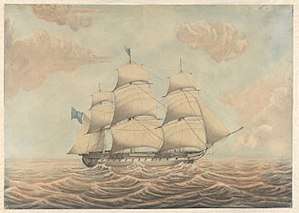HMS Stag (1830)
HMS Stag was a 44-gun Seringapatam-class fifth-rate frigate built for the Royal Navy during the 1820s, one of three ships of the Andromeda sub-class.
 Stag | |
| History | |
|---|---|
| Name: | Stag |
| Namesake: | Stag |
| Ordered: | 9 January 1823 |
| Builder: | Pembroke Dockyard |
| Laid down: | April 1828 |
| Launched: | 2 October 1830 |
| Completed: | 9 July 1831 |
| Commissioned: | 15 April 1831 |
| Fate: | Broken up by 8 August 1866 |
| General characteristics | |
| Class and type: | Seringapatam-class frigate |
| Tons burthen: | 1218 40/94 bm |
| Length: | |
| Beam: | 42 ft (12.8 m) |
| Draught: | 14 ft 8 in (4.5 m) |
| Depth: | 13 ft 3 in (4.0 m) |
| Sail plan: | Full-rigged ship |
| Complement: | 315 |
| Armament: |
|
Description
The Andromeda sub-class was a slightly enlarged and improved version of the Druid sub-class, with a more powerful armament.[1] Stag had a length at the gundeck of 159 feet 3 inches (48.5 m) and 133 feet 3 inches (40.6 m) at the keel. She had a beam of 42 feet (12.8 m), a draught of 14 feet 8 inches (4.5 m) and a depth of hold of 13 feet 3 inches (4.0 m). The ship's tonnage was 1167 42⁄94 tons burthen.[2] The Andromeda sub-class was armed with twenty-six 18-pounder cannon on her gundeck, ten 32-pounder carronades and a pair of 68-pounder guns on her quarterdeck and four more 32-pounder carronades in the forecastle. The ships had a crew of 315 officers and ratings.[3]
Construction and career
Stag, the fourth ship of her name to serve in the Royal Navy,[4] was ordered on 9 January 1823, laid down in April 1828 at Pembroke Dockyard, Wales, and launched on 2 October 1830.[3] She was completed for ordinary at Plymouth Dockyard in October 1830. The ship was commissioned on 15 April 1831 and ready for sea by 9 July.[2]
Notes
- Winfield, pp. 712–13
- Winfield, p. 717
- Winfield & Lyon, p. 110
- Colledge, p. 331
References
- Colledge, J. J.; Warlow, Ben (2006) [1969]. Ships of the Royal Navy: The Complete Record of all Fighting Ships of the Royal Navy (Rev. ed.). London: Chatham Publishing. ISBN 978-1-86176-281-8.
- Phillips, Lawrie; Lieutenant Commander (2014). Pembroke Dockyard and the Old Navy: A Bicentennial History. Stroud, Gloucestershire, UK: The History Press. ISBN 978-0-7509-5214-9.
- Winfield, Rif (2014). British Warships in the Age of Sail, 1817-1863 (epub). Barnsley, UK: Seaforth. ISBN 978-1-47383-743-0.
- Winfield, R.; Lyon, D. (2004). The Sail and Steam Navy List: All the Ships of the Royal Navy 1815–1889. London: Chatham Publishing. ISBN 978-1-86176-032-6.
External links
